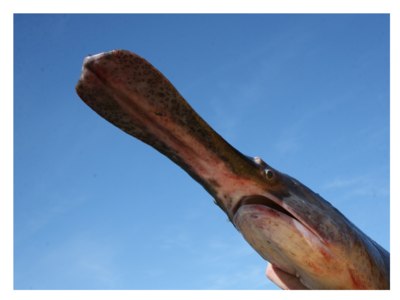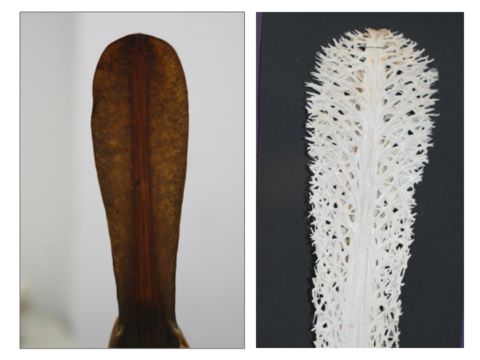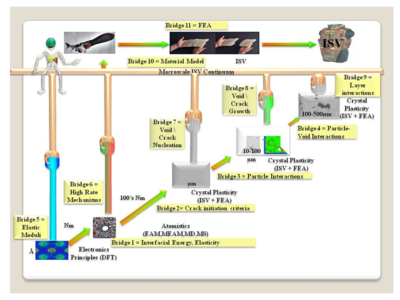Integrated Computational Materials Engineering (ICME)
Bio-Inspired Energy Dissipation System in Paddlefish
Paddlefish Characteristics

Figure 1: The Paddlefish
From the basic laws of physics, everything in nature has a tendency to
evolve to a state where survival is possible with the minimum possible
expenditure of energy. Rostrum of the Paddlefish is a very good example of this
phenomenon. The paddlefish (Polyondon spathula) can be easily distinguished by
the presence of its elongated rostrum Figure 1. It is among the most primitive
of bony-finned fishes (Osteichthyes, Actinopterygil) and together with
sturgeon, comprises an order of secondary cartilaginous fishes, the
Acipenseriformes [1]. Presently,
they constitute the most endangered group of species in North America. Their
population decline is attributed to habitat loss and degradation, overharvest
[2], alterations to natural river
flow regimes, and the construction of navigation dams on the Mississippi River
and the most common waterways in the mid-west, which limit or eliminate
spawning migrations.
The rostrum of paddlefish is a unique structure, comprising of a network of
cartilage, tissue, and interlocking star shaped bones called the stellate
bones. Figure 2 shows the stellate bone arrangement in a rostrum of paddlefish.
The function of the long, paddle-shaped snout has received considerable
attention. The sensory function of the rostrum enables them to detect the type
of flows [3] that allows them feed
efficiently in both laminar and turbulent currents. Additionally, the sensory
function allows the paddlefish to detect tiny zooplanktons without the benefit
of using their visual, chemical, or hydrodynamic senses
[4].

Figure 2: Paddlefish rostrum and Stellate bone arrangement.
Naturally occurring material are made from the simplest materials readily available in nature. They gain their strength from the unique hierarchical structure. Rostrum shows an incredible load transfer mechanism when it was subjected to blast and penetration loads. Several materials have been considered to reverse engineer the unique load resistance characteristics of the Rostrum to engineer superior materials that could be used for making blast resistant walls, bullet proof vests for soldiers etc.
ICME Approach for Designing Superior Bio-Inspired Materials

Figure 1: ICME approach for designing novel bio-inspired energy dissipating material.
Multi-scale simulations integrate the existing methods from different branches of science to fill the bridge of length and time that is inherent in designing new materials with superior properties. The design requirements are defined at the continuum application level. These design requirements are scaled down to the atomistic level where the structure of the matter is understood. The requirements of the end product are the beginning point of the ICME process. The entire process is based on the design requirements sent down from the continuum level internal state variables. Several studies have been carried out that use the multiscale approach. [5][6]. Figure 3 shows the proposed skeleton of the ICME approach that will be employed to develop superior strength materials.
Reference
1. J.D. Pettigrew, L. Wilkens, Paddlefish and Platypus: Parallel Evolution
of Passive Electroreception in a Rostral Bill Organ, Sensory Processing in
Aquatic Environments, 2003, pp. 420-433.
2. D.F. Williamson, Caviar and conservation – Status, management, and trade of
North American sturgeon and Paddlefish, TRAFFIC North America, Washington, D.
C.: World Wildlife Fund, 2003.
3. C. Gurgens, D.F. Russell, L.A. Wilkens, Electrosensory avoidance of metal
obstacles by the Paddlefish. Journal of Fish Biology, 57 (2000) 277-290.
4. L.A. Wilkens, D. F. Russell, X. Pei, C. Gurgens, The Paddlefish Rostrum
functions as an electrosensory antenna in plankton feeding. Proc. R. Soc. Lond.
B 264 (1997) 1723-1729.
5. S. J. V. Frankland, J. C. Riddick and T. S. Gates, Multi-scale
Rule-of-Mixtures Model of Carbon Nanotube/Carbon Fiber/Epoxy Lamina.
6. J F. Peters, J P. Allen, P G. Allison,T A. Carlson,M Q.Chandler, C F.
Cornwell, B D. Devine, F C. Hill, N. Jabari Lee, C P. Marsh,P B. Stynoski,
Laura Walizer, and C R. Welch, Towards Development of a Super Ceramic Composite
- Initial Investigation into Improvement of Strength and Toughness of
Polycrystalline Ceramics, Aug 2012.
